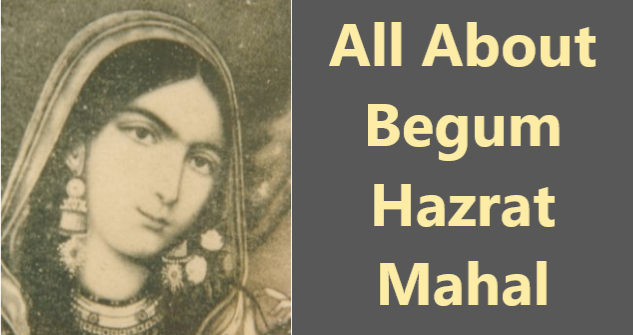All About Begum Hazrat Mahal: The Revolutionary Queen of Awadh
Sakshi Education
Begum Hazrat Mahal, Begum of Awadh (c.1820- 7 April 1879) was one of the few women who challenged the British during the revolt of 1857.


Her maiden name was Muhammadi Khanum. She was born at Faizabad, Awadh. Later in life, she performed a mut’ah marriage with Nawab Wajid Ali Shah.
Important Points About Begum Hazrat Mahal:
- Awadh was annexed by the British East India Company in 1856 and Nawab Wajid Ali Shah, the last Nawab of Awadh was sent into exile to Calcutta. Hazrat Mahal decided to stay back in Lucknow along with her son Birjis Qadir.
- After the absorption of Awadh, a rebellion broke out at Meerut and the banner of revolt was raised in Lucknow which spread rapidly to other towns of Awadh. Lucknow was the only place where the English did not leave the Residency building and faced the rebels until they were able to regain their lost power.
- Her closest allies were Nana Saheb and Maulvi Ahmad ullah Shah. Outram and Havelock arrived from Kanpur to relieve the British Garrison in the Residency of Lucknow. After a few encounters with the rebels, Outram was able to occupy Alum Bagh (a garden in the suburb of Lucknow) on September 23, 1857.
- Begum Hazrat Mahal often called meetings to encourage soldiers, asking them to be brave and fight for the cause.
- She wrote letters of instruction for the movement and is reported to have appeared on the battlefield on February 25, 1858, mounted on an elephant.
1857 భారతదేశ మొదటి స్వాతంత్య్ర సంగ్రామంలో బ్రిటిష్ వారిని ఎదిరించి, తీవ్ర యుద్ధంలో నాయకత్వ వహించిన యోధురాలు రాణి బేగం హజ్రత్ మహల్
— PIB in Andhra Pradesh (@pibvijayawada) May 4, 2023
షార్ట్ ఫిల్మ్ని విక్షించండి🎥#AzadiKiAmritKahaniyan #AmritMahotsav @MIB_India pic.twitter.com/IjXqJLic7u
- Alum Bagh was attacked by a force sometimes led by Maulvi Ahmad ullah Shah and at other times by the Begum in person but the British succeeded in defeating the rebel force.
- In March, British started operation against Lucknow under the command of Sir Colin Campbell. The force included 3000 Goorkhas sent by Jung Bahadur, Maharaja of Nepal for the capture of Lucknow.
- By March 19, 1858, Moosabagh, Char Bagh, and Kesar Bagh were captured by the British.
- Under adverse circumstances, Begum with her followers, her son Birjis Qadir and Nana Saheb escaped to Nepal. The Nepalese authorities were hesitant to give asylum to the rebels.
- Nepalese authorities later changed the decision and an asylum was given to her on the conditions that she did not hold any communication with the rebel leaders or with the people of India.
- She faced difficulties in Nepal where her son fell sick. The Lieutenant in charge of her at Noakote (Nepal) observed that Begum had plans to flee from Nepal as well.
- After the escape of Begum, the British declared that the rebels and their leaders must submit themselves for conspiring against the Government.
- The Begum tried to come back to India in 1877 but orders were issued, whereby any request made by either Birjis Qadir or his mother to enter British India would not be entertained.
- Begum Hazrat Mahal could not come to India and had to reside in Nepal permanently. She died in 1879. The grave of Begum Hazrat Mahal is in Kathmandu. On 10 May 1984, a Postage Stamp was issued in her honour.
- The indomitable Begum became one of the few women to fight against the British in the first war of Independence.
Also Read:
Published date : 04 May 2023 06:00PM















